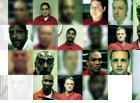|
 |
|

|
USA. NEW STUDY CASTS DOUBT ON RELIABILITY OF LETHAL INJECTION DRUGS
April 24, 2007: a new scientific study of 41 lethal injections that took place in California and North Carolina during the past two decades revealed that two of the three drugs used to carry out these executions are not administered in a way that reliably produces death in the way intended.
The study, published in the Public Library of Science Journal, PLoS Medicine, found that inmates were given a uniform amount of anesthesia (sodium thiopental) regardless of their body weight or other factors, such as their tolerance for barbiturates. Researchers concluded that this practice led to dosages that are below what is necessary to have a 50-50 chance of euthanizing many laboratory animals, such as rabbits, dogs, and rats. Without sufficient anesthesia, inmates would feel as if they were being strangled while the second drug, pancuronium bromide, asphyxiated them by bringing on paralysis. Then they would feel a burning sensation from the third drug, potassium chloride. The study also found evidence that the potassium chloride was not always inducing cardiac arrest as expected.
"There may or may not be enough anesthetic onboard for the whole process to do its thing. There's a window for at least part of the process where they may be quite uncomfortable," said Dr. Leonidas Koniaris, a surgical oncologist at the University of Miami Miller School of Medicine and lead author of the study. Deborah Denno, a Fordham University law professor who has studied lethal injections for 15 years, added, "The argument that's always been given about lethal injection is that in theory, a well-trained person could give it humanely.
This casts doubt on even that."
Koniaris and his team chose to review executions in California and North Carolina because those states had the most complete information available. The authors of the study included an anesthesiologist, a pharmacologist, a molecular biologist, a veterinarian, an attorney and a historian. (Sources: Los Angeles Times, 24/04/2007)
|

